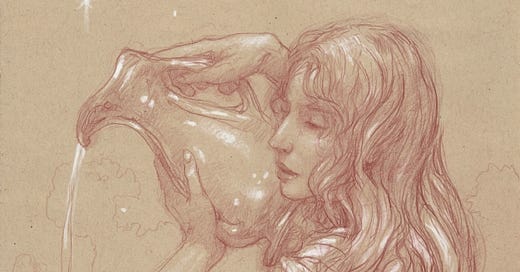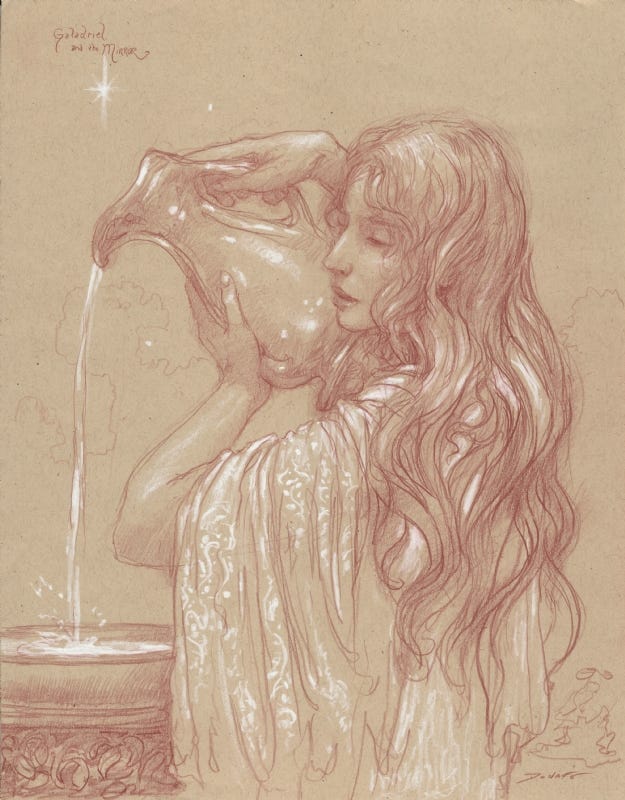Galadriel: The Proud and Penitent
“The love of the Elves for their land and their works is deeper than the deeps of the Sea, and their regret is undying and cannot ever wholly be assuaged. Yet they will cast all away rather than submit to Sauron: for they know him now.”
-The Lord of the Rings, The Fellowship of the Ring, “The Mirror of Galadriel”
These words, spoken to Frodo by Galadriel, have always lingered in my mind. As a teen reading them for the first time, I was immediately struck by the profound sadness of loss inescapable that they so perfectly conveyed. Up until the Lothlórien chapters, my limited knowledge of Tolkienian Elves was that they were strong, wise, and generally rather jovial, if a bit aloof. What was this regret that she spoke of, and why was it undying? These allusions immediately fostered in me a keen interest in the Elves, and a desire to learn more of their legends and where Galadriel fit into them. After all, throughout the familiar stories of the Third Age, we get only glimpses into that primeval history of great deeds, now fading, through the eyes of five little hobbits in a wide world beyond their imagining.
Much to my delight, I came to learn rather quickly that a tome of such tales existed! After finishing The Lord of the Rings (a little less than a year before the first movie of the Jackson trilogy was released), I dove straight into The Silmarillion. I had always loved a good book, but I had wholly and fervently immersed myself into the Legendarium, as I later came to know it. As with many first-time readers of The Silmarillion, I was often puzzled, and always enchanted (except for chapter 14, which I have learned to appreciate over time), but left yearning for more after I finished it. I loved reading about the Elder Days, but why was Galadriel featured so sparsely? For such an important figure at the time of The War of the Ring, it seemed her history should have been far more prominent; yet she is mentioned but a handful of times throughout The Silmarillion. More often than not, these references simply stated where she was residing at the time and to whom she was related. I had hoped for more. Surely there must be more.
The next title on my journey of discovery would be Unfinished Tales of Númenor and Middle-earth. I learned that this needn’t be read in order, so of course the first chapter that I feverishly turned to was “The History of Galadriel and Celeborn”. Christopher Tolkien’s words jumped off the page as a sort of disclaimer, or challenge:
“There is no part of the history of Middle-earth more full of problems than the story of Galadriel and Celeborn, and it must be admitted that there are severe inconsistencies ‘embedded in the traditions’ […]”
My heart sank a bit, but I was also propelled by the hubris of youth, determined to make sense of it all. I was convinced that the story of Galadriel and her trophy husband must have some underlying cohesion that a careful reader could piece together. I obviously had much to learn about the concept of “canon” within Tolkien’s writings; but that is a topic for another essay altogether.
I pored over the pages, only to be left feeling more perplexed than ever. The disparate versions of her history had common threads, but the differences were substantial and it was truly impossible to reconcile them all. If you have ever seen the movie Clue, “The History of Galadriel and Celeborn” reads much like the rather ingenious multiple endings baked into the script.
It’s brilliant for a black comedic murder mystery based on a board game, but less endearing when trying to align the constituent parts of a tragic tale of sorrow and loss. Galadriel was one of the few Noldor left in Middle-earth at the end of the Third Age. How was it that she endured when the rest of her family had perished in the wars against the Enemies? There was no clear answer in the text. I set the matter aside, and over time and with much study, learned to appreciate the inherent inconsistencies in the Legendarium; these could simply be the different perspectives of Middle-earth’s historians. It’s a fun in-universe explanation that Tolkien himself embraced. He was creating an imagined history for our own world, and history is full of differing and sometimes inconsistent perspectives.
Then I read The Letters of J.R.R. Tolkien, which was like a bolt out of the blue. It is cited with a high degree of frequency, but that is because letter #131 to Milton Waldman (1951) is one of the most helpful lenses through which to view Tolkien’s “sub-creation”, as he called it.
“I would draw some of the great tales in fullness, and leave many only placed in the scheme, and sketched. The cycles should be linked to a majestic whole, and yet leave scope for other minds and hands, wielding paint and music and drama.”
Still earlier in the same letter, he reflects that, “I do not remember a time when I was not building it.”
So we can circle back around to Galadriel, who is in both the sketches and the tales told in fullness. Furthermore, she wasn’t imagined in thought until Tolkien had begun writing The Lord of the Rings, after he had already sketched out much of the history of the Elder Days (which is what he had really hoped to complete and have published after the success of The Hobbit, but it was rejected by Allen & Unwin). This complicated matters, as her existence as a Noldo of great power and wisdom at the end of the Third Age necessitated a certain degree of revision to those earlier histories of the Eldar. It is then prudent to focus not simply on what Galadriel was doing, but on who Galadriel was; what were her essential character traits and how did she come to be the sole surviving member of the Valinorean House of Finwë in Middle-earth at the time of the War of the Ring? This information sometimes must be inferred from context; we must understand her foils, and what sets her apart from them despite possessing many of the same gifts and perilous desires. She must be mighty to have endured the malice of both Morgoth and Sauron. Indeed, in Eregion Sauron “perceived at once that Galadriel would be his chief adversary and obstacle, and he endeavoured therefore to placate her, bearing her scorn with outward patience and courtesy.”
-Unfinished Tales of Númenor and Middle-earth, “The History of Galadriel and Celeborn”
I hope you will join me on this series of short essays dedicated to exploring Galadriel: proud daughter of the Noldor, bastion of resistance against Sauron, and penitent Lady of Lórien.






